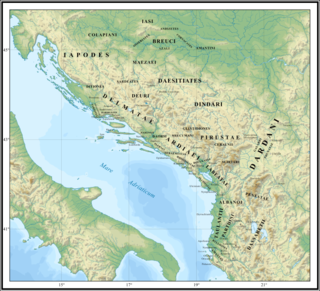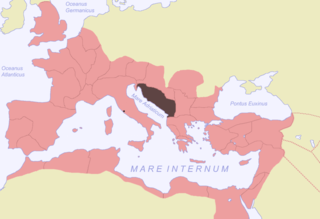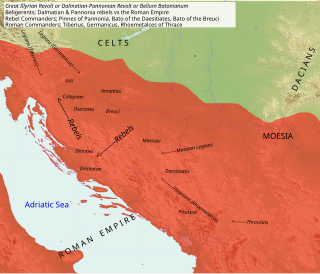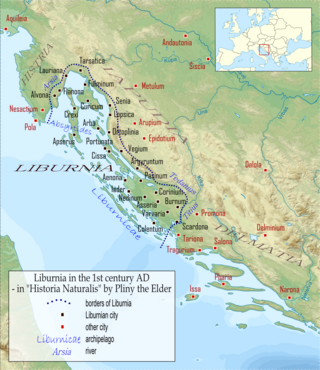Related Research Articles

In classical antiquity, Illyria was a region in the western part of the Balkan Peninsula inhabited by numerous tribes of people collectively known as the Illyrians. Illyrians spoke the Illyrian language, an Indo-European language, which in ancient times perhaps also had speakers in some parts of Southern Italy.

The Illyrians were a group of Indo-European-speaking peoples who inhabited the western Balkan Peninsula in ancient times. They constituted one of the three main Paleo-Balkan populations, along with the Thracians and Greeks.
The Dardani or Dardanians were a Paleo-Balkan people, who lived in a region that was named Dardania after their settlement there. They were among the oldest Balkan peoples, and their society was very complex. The Dardani were the most stable and conservative ethnic element among the peoples of the central Balkans, retaining for several centuries an enduring presence in the region.
Taulantii or Taulantians were an Illyrian people that lived on the Adriatic coast of southern Illyria. They dominated at various times much of the plain between the rivers Drin (Drilon) and Vjosa (Aoös). Their central area was the hinterland of Epidamnos-Dyrrhachion, corresponding to present-day Tirana and the region between the valleys of Mat and Shkumbin (Genusus). The Taulantii are among the oldest attested Illyrian peoples, who established a powerful kingdom in southern Illyria. They are among the peoples who most marked Illyrian history, and thus found their place in the numerous works of historians in classical antiquity.

The Histri were an ancient people inhabiting the Istrian Peninsula, to which they gave the name. Their territory stretched to the neighbouring Gulf of Trieste and bordered the Iapydes in the hinterland of Tarsatica. The Histri formed a kingdom.
The Delmatae, alternatively Dalmatæ, during the Roman period, were a group of Illyrian tribes in Dalmatia, contemporary southern Croatia and western Bosnia and Herzegovina. The region of Dalmatia takes its name from the tribe.

Illyricum was a Roman province that existed from 27 BC to sometime during the reign of Vespasian. The province comprised Illyria/Dalmatia in the south and Pannonia in the north. Illyria included the area along the east coast of the Adriatic Sea and its inland mountains, eventually being named Dalmatia. Pannonia included the northern plains that now are a part of Serbia, Croatia and Hungary. The area roughly corresponded to part or all of the territories of today's Albania, Kosovo, Montenegro, Serbia, Bosnia and Herzegovina, Croatia, and Slovenia.

The Bellum Batonianum was a military conflict fought in the Roman province of Illyricum in the 1st century AD, in which an alliance of native peoples of the two regions of Illyricum, Dalmatia and Pannonia, revolted against the Romans. The rebellion began among native peoples who had been recruited as auxiliary troops for the Roman army. They were led by Bato the Daesitiate, a chieftain of the Daesitiatae in the central part of present-day Bosnia and Herzegovina, and were later joined by the Breuci, a tribe in Pannonia led by Bato the Breucian. Many other tribes in Illyria also joined the revolt.
The Ardiaei were an Illyrian people who resided in the territory of present-day Albania, Serbia, Montenegro, Bosnia and Herzegovina and Croatia between the Adriatic coast on the south, Konjic on the north, along the Neretva river and its right bank on the west, and extending to Lake Shkodra to the southeast. From the 3rd century BC to 168 BC the capital cities of the Ardiaean State were Rhizon and Scodra.

Daesitiates were an Illyrian tribe that lived on the territory of today's central Bosnia, during the time of the Roman Republic. Along with the Maezaei, the Daesitiates were part of the western group of Pannonians in Roman Dalmatia. They were prominent from the end of the 4th century BC up until the beginning of the 3rd century CE. Evidence of their daily activities can be found in literary sources, as well as in the rich material finds from Central Bosnian cultural group that is commonly associated with tribe of Daesitiates.
The Parthini, Partini or Partheni were an Illyrian tribe that lived in the inlands of southern Illyria. They likely were located in the Shkumbin valley controlling the important route between the Adriatic Sea and Macedonia, which corresponded to the Via Egnatia of Roman times. Consequently, their neighbours to the west were the Taulantii and to the east the Dassaretii in the region of Lychnidus.

Delminium was an Illyrian city and the capital of the Dalmatia which was located somewhere near today's Tomislavgrad, Bosnia and Herzegovina, under which name it also was the seat of a Latin bishopric.
The history of Illyrian warfare of the Illyrians spans from the beginning of the 2nd millennium BC up to the 1st century AD in the region of Illyria and in southern Italy where the Iapygian civilization flourished.

The Illyrian language was an Indo-European language or group of languages spoken by the Illyrians in Southeast Europe during antiquity. The language is unattested with the exception of personal names and placenames. Just enough information can be drawn from these to allow the conclusion that it belonged to the Indo-European language family.

The Labeatae, Labeatai or Labeates were an Illyrian people that lived on the Adriatic coast of southern Illyria, between modern Albania and Montenegro, around Lake Scodra.
The Penestae were an Illyrian tribe dwelling in southeastern Illyria, in an inland region that was called Penestia, which was located around the Black Drin valley north of Lake Ohrid, between present-day eastern Albania and western North Macedonia. They are firstly mentioned by ancient Roman historian Livy. They appear several times in Livy's accounts of the events concerning the Third Macedonian War, which was fought between the Roman Republic and the Kingdom of Macedonia under Perseus. Their chief city was Uscana, most likely located in the valley of the Black Drin in the region of Dibra.
The Sardiatae or Sardiates were an Illyrian tribe that lived in Dalmatia, in the Pliva valley around the area of Jajce and Šipovo, in present-day Bosnia and Herzegovina. They are mentioned by Pliny the Elder, who locates them in the conventus iuridicus of Salonae, and reports that they had 52 decuriae. They are also mentioned by Ptolemy, and in the Libri Coloniarum of the Gromatici Veteres along with the Tariotes.
References
- 1 2 Kuzmanovska 2017 , pp. 105–106
- ↑ Baldi 2002, p. 116.
- ↑ Dzino 2010, p. 164.
- ↑ Wilkes 1996, p. 578.
- ↑ Wilkes 1962, p. 192.